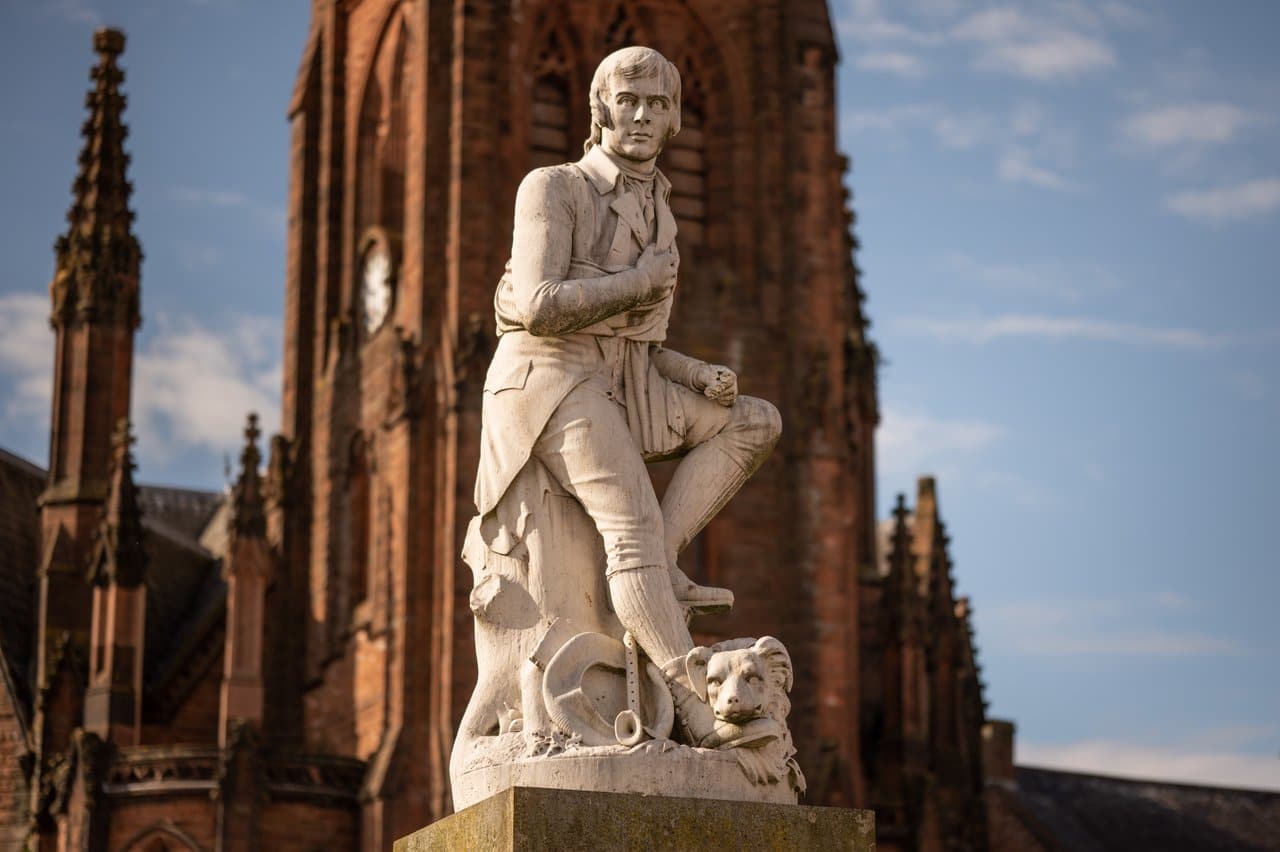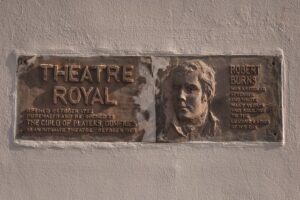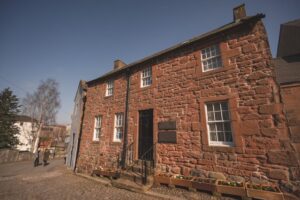
Campaigners in Dumfries call for the town to be recognised as the place where Robert Burns lived, loved, worked and died
As revellers link arms around the world to welcome 2024 with a rendition of Auld Lang Syne, a new action group in the South of Scotland has launched a campaign to celebrate Dumfriesshire’s unparalleled connections to Scotland’s National Bard in a bid to unlock millions of pounds in tourism revenue for the region.
Though he was born in Alloway, Ayrshire, Burns chose to make a life for himself in Dumfriesshire, where he built Ellisland Farm in 1788, writing Auld Lang Syne there the very same year.
Dumfries and its environs boast several iconic Burns heritage sites and in 2019 the area’s Burns connections were estimated to have generated £21 million in visitor spend for the Scottish economy. However, that same year Alloway generated around £100 million more than that.
- Theatre Royal Dumfries
- Robert Burns House
Highlighting the importance of Dumfries as Robert Burns’ chosen home, The Burns Tourism Action Group has formed to bring to life their vision for a holistic Burns tourism offer in the region, where the poet lived, composed and performed during some of the most prolific years of his life.
The spirit of the Bard lives on in Dumfries, from his “favourite howff”, The Globe Inn, which dates from 1610, and the Theatre Royal, Scotland’s oldest working theatre, where he wrote and performed, to his red sandstone home, Robert Burns House, a place of pilgrimage for Burns enthusiasts from across the world, and his final resting place at the majestic Robert Burns Mausoleum.
With such a wealth of fascinating Burns sites, the group now seeks to establish the Dumfries and Nithsdale area as a globally recognised destination for all things Burns.
The Burns Tourism Action Group is supported by Dumfries and Galloway Council and the South of Scotland Destination Alliance. Working with numerous partners, the group has drawn up a six-month plan to promote Burns tourism in Dumfriesshire, aiming to increase the number of Burns-related visitors and promote a compelling and coordinated experience, as well as continuing to protect and celebrate the legacy of Burns in the region.
Comprising 16 steps, the action plan includes devising a new Burns audio walking tour, a guides portal and new signage at all major Burns heritage sites with QR codes across the town linking to a new website where visitor information, Burns insights and walking routes will all be available in one place.
The idea of a Burns Quarter in Dumfries, which was initiated by Professor David Thomson and Teresa Church, custodians of The Globe Inn, will be at the centre of the Burns initiative for Dumfries. It will be joined by the Old Bakery opposite The Globe Inn once planning permission is granted by Dumfries and Galloway Council and the two buildings will form the beating heart of Burns heritage in Dumfries, with hopes of inspiring townspeople and visitors alike for generations to come. Plans include a new visitor centre, museum, exhibition and conference centre.
David Hope-Jones, CEO of the South of Scotland Destination Alliance, said: “We are delighted to be involved in this collaborative effort to highlight Dumfries’ irrefutable claim to be the true ‘Bard’s Town’.
“This incredible part of Scotland has such a special connection with Robert Burns: it is the place where he chose to build a life for himself and his family and where he composed some of his most celebrated works. There is a palpable sense of pride in the Burns heritage in Dumfriesshire, and you can really see that through the commitment to honouring his legacy through the myriad Burns attractions in the area.
“Auld Lang Syne is sung every New Year’s Eve not just here in Scotland, but across the globe. There is so much potential for this universal love of Burns to draw in tourists both locally and from further afield and we’ve seen real enthusiasm from our partners to make that a reality. When it comes to Burns, it’s time to really turn the spotlight on to Dumfriesshire.”
Burns composed a quarter of all of his songs and poems while living at Ellisland Farm, including the famous narrative poem “Tam O’Shanter” and Auld Lang Syne, while also attempting to make a living through farming. The farm is now a fascinating museum, offering invaluable insight into the poet’s day-to-day life.
Joan McAlpine, Business Manager for the Robert Burns Ellisland Trust, said: “We have great plans in store for Burns Tourism in and around Dumfries and we can’t wait to swing into action in earnest as the New Year dawns.
“As we sing Auld Lang Syne together at Hogmanay, we celebrate the ageless spirit of the Bard – and that’s exactly what this new partnership aims to do all year round. Visitors to the area will quickly realise that the living legacy of Robert Burns is woven through the very fabric of Dumfriesshire.”
In the grounds of Ellisland Farm, visitors can now book and stay in the romantic farmstead home of Burns and Jean Armour, Auld Acquaintance Cottage.
Ms McAlpine added: “Bookable all winter, Auld Acquaintance Cottage offers modern luxury in a rustic style – and you are immersed in the landscape which inspired Burns to write his finest work! You can also walk the paths by the Nith which he enjoyed and drink in the dark skies which make Dumfries and Galloway so special.”
The historic Globe Inn opened its doors in 1610, making it one of Scotland’s oldest working pubs, and where Burns often lodged during what is said to be the happiest time of his life. Visitors can read his poetry scratched into the windowpanes and admire the many Burns murals on the interior and exterior walls of the pub.
They can also sit in his chair, provided they are willing to recite a line of Burns, or else take the forfeit and buy a round of drinks for everyone in the pub!
David Thomson, custodian of The Globe Inn and initiator of the Burns Quarter, said: “The Burns Quarter in Dumfries isn’t solely about keeping the memory of Robert Burns alive, it’s also about bringing Burns’ words to life, to influence the way we think about ourselves today and the kind of world we want to live in. Maybe we should all be… “truly sorry Man’s Dominion, Has broken nature’s social union”…and do something about it before it’s too late. What poignant words! There’s so much that we can still learn from Burns. Bringing Burns to life in the centre of Dumfries is what our Burns Quarter is all about.”
The Burns Tourism Action Group is part of the Burns Tourism Partnership, which comprises the following partner organisations: the SSDA, Robert Burns Ellisland Museum and Farm, Dumfries and Galloway Council, Theatre Royal Dumfries, The Globe Inn, Big Burns Supper, The Stove, DG Unlimited, Wigtown Book Festival, Annandale Distillery, Galloway Cycling Holidays, University of Glasgow, A @ the Airts, VisitScotland and SOSE, as well as others.
AULD LANG SYNE – FAST FACTS
- Auld Lang Syne has been sung at New Year in Scotland since the nineteenth century, and became tradition in North America after Guy Lombardo and the Royal Canadians broadcast it on December 31, 1929
- It is believed Auld Lang Syne (either with or without Burns’ lyrics) is sung at the bells in hundreds of countries around the world
- Robert Burns wrote the lyrics to Auld Lang Syne at Ellisland Farm, where he composed a quarter of all of his songs and poems including the world-famous poem “Tam O’Shanter”
- Auld Lang Syne is based on an older Scottish song and was later set to a traditional Scottish melody
- Burns wrote the song in 1788 and it was first published in volume five of James Johnson’s Scots Musical Museum in 1796, shortly after Burns’ death from rheumatic fever at the age of 37
- The Japanese version of Auld Lang Syne, called Hotaru no hikari, is often sung in schools, during graduation ceremonies and at the end of the school day. It also marks closing time in shops and restaurants
- The hand-linking in the song has been linked to freemasonry, as singing with arms crossed and hands joined was a parting ritual at Masonic lodges. Burns himself was a Freemason
- In 1877 Alexander Bell used Auld Lang Syne to demonstrate the telephone
- The song is said to have spread via Scots living in London and abroad and through the Scouts at the first World Scout Jamboree in 1920
LYRICS
Should auld acquaintance be forgot,
and never brought to mind?
Should auld acquaintance be forgot,
and auld lang syne.
CHORUS:
For auld lang syne, my jo,
for auld lang syne,
we’ll tak a cup o’ kindness yet,
for auld lang syne.
And surely ye’ll be your pint-stowp!
and surely I’ll be mine!
And we’ll tak a cup o’ kindness yet,
for auld lang syne.
We twa hae run about the braes,
and pu’d the gowans fine;
But we’ve wander’d mony a weary fit,
sin auld lang syne.
We twa hae paidl’d i’ the burn,
frae morning sun till dine;
But seas between us braid hae roar’d
sin auld lang syne.
And there’s a hand, my trusty fiere!
and gie’s a hand o’ thine!
And we’ll tak a right gude-willy waught,
for auld lang syne.






